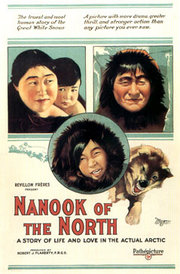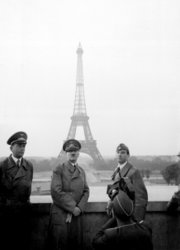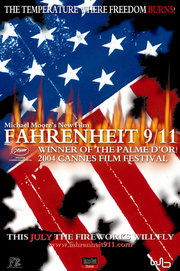Documentary
Documentary film is a broad category of cinematic expression united by the intent to remain factual or non-fictional. more...
History
Pre-1900
The French used the term to refer to any non-fiction including travelogues and instructional videos. The earliest "moving pictures" were by definition documentary. They were single shots, moments captured on film, whether of a train entering a station, a boat docking, or a factory of people getting off work. Early film (pre-1900) was dominated by the novelty of showing an event. These short films were called (ctuality film|actuality films) Very little storytelling took place before the turn of the century, due mostly to technological limitations: cameras could hold only very small amounts of film; many of the first films are a minute or less in length.
Romanticism
With Robert J. Flaherty's Nanook of the North in 1922, documentary film embraced romanticism; Flaherty went on to film a number of heavily staged romantic films, usually showing how his subjects would have lived 100 years earlier and not how they lived right then (for instance, in Nanook of the North Flaherty does not allow his subjects to shoot a walrus with a nearby shotgun, but has them use a harpoon instead, putting themselves in considerable danger).
Some of Flaherty's staging, such as building a roofless igloo for interior shots, was done to accommodate the filming technology of the time.
Newsreel tradition
The newsreel tradition is an important tradition in documentary film; newsreels were also sometimes staged but were usually reenactments of events that had already happened, not attempts to steer events as they were in the process of happening. For instance, much of the battle footage from the early 20th century was staged -- the cameramen would usually arrive on site after a major battle and reenact scenes to film them. Dziga Vertov was involved with the Russian Kino-Pravda newsreel series ("Kino-Pravda" means literally, "film-truth," a term that was later translated literally into the French cinema verite). Frank Capra's Why We Fight series was a newsreel series in the United States, commissioned by the government to convince the U.S. public that it was time to go to war.
Realist tradition
The continental, or realist, tradition focused on man within man-made environments, and included the so-called "city symphony" films such as Berlin, Symphony of a City, Rien que les Heures, and Man with the Movie Camera. These films tended to feature people as products of their environment, and leaned towards the impersonal or avant-garde.
Propagandist tradition
The propagandist tradition consisted of films made with the explicit purpose of persuading an audience of a point. One of the most notorious propaganda films is Leni Riefenstahl's film Triumph of the Will. Why We Fight was explicitly contracted as a propaganda newsreel series in response to this, covering different aspects of World War II, and had the daunting task of persuading the US public to go to war. The series has been selected for preservation in the United States' National Film Registry. In Britain, Humphrey Jennings succeeded in blending propaganda with a poetic approach to documentary.
J. Grierson and D. Vertov
In the 1930s, documentarian and film critic John Grierson argued in his essay First Principles of Documentary that Robert Flaherty's film Moana had "documentary value," and put forward a number of principles of documentary. These principles were that cinema's potential for observing life could be exploited in a new art form; that the "original" actor and "original" scene are better guides than their fiction counterparts to interpreting the modern world; and that materials "thus taken from the raw" can be more real than the acted article. In this regard, Grierson's views align with Dziga Vertov's contempt for dramatic fiction as "bourgeois excess," though with considerably more subtlety. Grierson's definition of documentary as "creative treatment of actuality" has gained some acceptance, though it presents philosophical questions about documentaries containing stagings and reenactments.
In his essays, Vertov argued for presenting "life as it is" (that is, life filmed surreptitiously) and "life caught unawares" (life provoked or surprised by the camera). Cinema verite borrows from both Italian neorealism's penchant for shooting non-actors on location, and the French New Wave's use of largely unscripted action and improvised dialogue; the filmmakers took advantage of advances in technology allowing smaller, handheld cameras and synchronized sound to film events on location as they unfold.
Cinéma vérité
The films Harlan County, U.S.A. (directed by Barbara Kopple), Dont Look Back (D. A. Pennebaker), Lonely Boy (Wolf Koenig and Roman Kroitor) and Chronicle of a Summer (Jean Rouch) are all considered cinéma vérité. Although sometimes used interchangeably, there are important differences between cinéma vérité (Jean Rouch) and the North American "Direct Cinema", pioneered among others by French Canadian Michel Brault, Pierre Perrault, Richard Leacock, Frederick Wiseman and Albert and David Maysles. The directors of the movement take different viewpoints on their degree of involvement, Kopple and Pennebaker, for instance, choosing non-involvement, and Rouch, Koenig, and Kroitor favoring direct involvement or even provocation when they deem it necessary. The fundamentals of the style include following a person during a crisis with a moving camera (not a tripod) to capture more personal reactions. There are no sit-down interviews, and the shooting ratio (the amount of film shot to the finished product) is very high, often reaching 80:1. From there, editors find and sculpt the work into a film. The editors of the movement, Charlotte Zwerin, Muffie Myers, Susan Froemke, and Ellen Hovde are often overlooked, but their input to the film so vital that they were often given co-director credits. Famous cinéma vérité/direct cinema films include Showman, Salesman, The Children Were Watching, Primary, Behind a Presidential Crisis, and Grey Gardens.
Read more at Wikipedia.org





